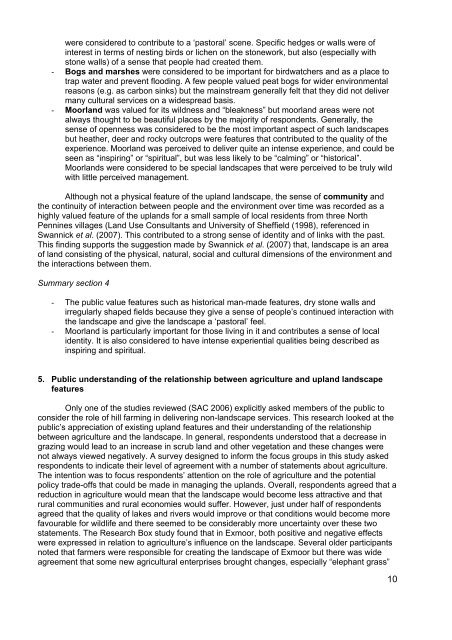Public Attitudes and Preferences for Upland Landscapes - Defra
Public Attitudes and Preferences for Upland Landscapes - Defra
Public Attitudes and Preferences for Upland Landscapes - Defra
You also want an ePaper? Increase the reach of your titles
YUMPU automatically turns print PDFs into web optimized ePapers that Google loves.
were considered to contribute to a ‘pastoral’ scene. Specific hedges or walls were of<br />
interest in terms of nesting birds or lichen on the stonework, but also (especially with<br />
stone walls) of a sense that people had created them.<br />
- Bogs <strong>and</strong> marshes were considered to be important <strong>for</strong> birdwatchers <strong>and</strong> as a place to<br />
trap water <strong>and</strong> prevent flooding. A few people valued peat bogs <strong>for</strong> wider environmental<br />
reasons (e.g. as carbon sinks) but the mainstream generally felt that they did not deliver<br />
many cultural services on a widespread basis.<br />
- Moorl<strong>and</strong> was valued <strong>for</strong> its wildness <strong>and</strong> “bleakness” but moorl<strong>and</strong> areas were not<br />
always thought to be beautiful places by the majority of respondents. Generally, the<br />
sense of openness was considered to be the most important aspect of such l<strong>and</strong>scapes<br />
but heather, deer <strong>and</strong> rocky outcrops were features that contributed to the quality of the<br />
experience. Moorl<strong>and</strong> was perceived to deliver quite an intense experience, <strong>and</strong> could be<br />
seen as “inspiring” or “spiritual”, but was less likely to be “calming” or “historical”.<br />
Moorl<strong>and</strong>s were considered to be special l<strong>and</strong>scapes that were perceived to be truly wild<br />
with little perceived management.<br />
Although not a physical feature of the upl<strong>and</strong> l<strong>and</strong>scape, the sense of community <strong>and</strong><br />
the continuity of interaction between people <strong>and</strong> the environment over time was recorded as a<br />
highly valued feature of the upl<strong>and</strong>s <strong>for</strong> a small sample of local residents from three North<br />
Pennines villages (L<strong>and</strong> Use Consultants <strong>and</strong> University of Sheffield (1998), referenced in<br />
Swannick et al. (2007). This contributed to a strong sense of identity <strong>and</strong> of links with the past.<br />
This finding supports the suggestion made by Swannick et al. (2007) that, l<strong>and</strong>scape is an area<br />
of l<strong>and</strong> consisting of the physical, natural, social <strong>and</strong> cultural dimensions of the environment <strong>and</strong><br />
the interactions between them.<br />
Summary section 4<br />
- The public value features such as historical man-made features, dry stone walls <strong>and</strong><br />
irregularly shaped fields because they give a sense of people’s continued interaction with<br />
the l<strong>and</strong>scape <strong>and</strong> give the l<strong>and</strong>scape a ‘pastoral’ feel.<br />
- Moorl<strong>and</strong> is particularly important <strong>for</strong> those living in it <strong>and</strong> contributes a sense of local<br />
identity. It is also considered to have intense experiential qualities being described as<br />
inspiring <strong>and</strong> spiritual.<br />
5. <strong>Public</strong> underst<strong>and</strong>ing of the relationship between agriculture <strong>and</strong> upl<strong>and</strong> l<strong>and</strong>scape<br />
features<br />
Only one of the studies reviewed (SAC 2006) explicitly asked members of the public to<br />
consider the role of hill farming in delivering non-l<strong>and</strong>scape services. This research looked at the<br />
public’s appreciation of existing upl<strong>and</strong> features <strong>and</strong> their underst<strong>and</strong>ing of the relationship<br />
between agriculture <strong>and</strong> the l<strong>and</strong>scape. In general, respondents understood that a decrease in<br />
grazing would lead to an increase in scrub l<strong>and</strong> <strong>and</strong> other vegetation <strong>and</strong> these changes were<br />
not always viewed negatively. A survey designed to in<strong>for</strong>m the focus groups in this study asked<br />
respondents to indicate their level of agreement with a number of statements about agriculture.<br />
The intention was to focus respondents’ attention on the role of agriculture <strong>and</strong> the potential<br />
policy trade-offs that could be made in managing the upl<strong>and</strong>s. Overall, respondents agreed that a<br />
reduction in agriculture would mean that the l<strong>and</strong>scape would become less attractive <strong>and</strong> that<br />
rural communities <strong>and</strong> rural economies would suffer. However, just under half of respondents<br />
agreed that the quality of lakes <strong>and</strong> rivers would improve or that conditions would become more<br />
favourable <strong>for</strong> wildlife <strong>and</strong> there seemed to be considerably more uncertainty over these two<br />
statements. The Research Box study found that in Exmoor, both positive <strong>and</strong> negative effects<br />
were expressed in relation to agriculture’s influence on the l<strong>and</strong>scape. Several older participants<br />
noted that farmers were responsible <strong>for</strong> creating the l<strong>and</strong>scape of Exmoor but there was wide<br />
agreement that some new agricultural enterprises brought changes, especially “elephant grass”<br />
10
















